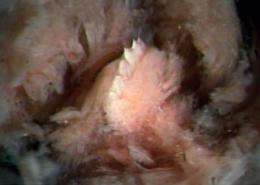The new T. rex: A leech with an affinity for noses

A new leech species with ferociously large teeth -- recently discovered in noses of children that swam in Peruvian rivers -- is providing insight into the evolutionary relationships among all the leeches that have an affinity for mucus membranes and orifices. Tyrannobdella rex was discovered in the remote Upper Amazon; its regular host remains unknown.
The new T. rex has ferociously large teeth lining a single jaw. But its length is less than 2 inches. Tyrannobdella rex, which means tyrant leech king, is a new species of blood sucker that lives in the remote parts of the Upper Amazon. Although its regular host remains unknown, it was discovered three years ago in Perú when a 44.5 millimeter leech was plucked from the nose of a girl who had recently been bathing in a river. The new species, described in PLoS ONE, has led to revising the group of leeches that has a habit of feeding from body orifices of mammals.
"Because of our analysis of morphology and DNA, we think that Tyrannobdella rex is most closely related to another leech that gets into the mouths of livestock in Mexico," says Anna Phillips, a graduate student affiliated with the American Museum of Natural History and the first author of the paper. "We think the leech could feed on aquatic mammals, from their noses and mouths for example, where they could stay for weeks at a time."
Discoveries of new leech species are not uncommon occurrences. Although there are 600 to 700 species of described leeches, it is thought that there could be as many as10,000 species throughout the world in marine, terrestrial and fresh water environments. Tyrannobdella rex was first brought to the attention of Mark Siddall, curator in the Division of Invertebrate Zoology at the Museum, when he received a specimen collected by Dr. Renzo Arauco-Brown, a Peruvian medical doctor from the School of Medicine at the Universidad Peruana Cayetano Heredia in Lima who was working at a clinic in Chanchamayo province. Siddall immediately recognized it as a new species. His student Alejandro Oceguera-Figueroa described its weird morphology—a single jaw with eight very large teeth, and extremely small genitalia. Two earlier cases from 1997 were re-discovered from different clinics in the western Amazon, one from Lamas province and the other from Yochegua province.
The new genus and species, Tyrannobdella rex, has led to a revision of the phylogenetic relationships among several leech families. Both morphological and genetic data show that this species is most closely related to Pintobdella chiapasensis, a leech from Chiapas that is typically hosted by tapir but also infests cows. Part of the research for this paper involved a Mexican expedition by Phillips and Oceguera-Figueroa to gather new specimens for DNA analysis. Close by on the phylogenetic tree, this group is related to leeches found in India and Taiwan like Dinobdella ferox, the terrible, ferocious leech that is well-known for feeding on mucus membranes and getting into various human orifices. All of these species, and others from Mexico, Africa, and the Middle East, make up the family Praobdellidae, a group of leeches that seems to share this feeding behavior and which can pose a risk to human health in certain parts of the world.
The evolutionary relationship among leeches that currently inhabit distant regions suggests that the common ancestor of this group must have lived when the continents were pressed together into a single land mass, before Pangaea broke up.
"We named it Tyrannobdella rex because of its enormous teeth. Besides, the earliest species in this family of these leeches no-doubt shared an environment with dinosaurs about 200 million years ago when some ancestor of our T. rex may have been up that other T. rex's nose," says Siddall. "The new T. rex joins four other species that use this abbreviated name, including two Miocene fossils (a snail and a scarab beetle), a living Malaysian formicid ant, and, of course, the infamous Cretaceous theropod dinosaur that was described in 1905 by an earlier curator of the American Museum of Natural History."
More information: Paper: dx.plos.org/10.1371/journal.pone.0010057
Provided by American Museum of Natural History


















